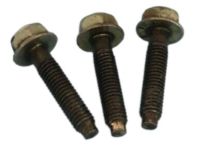Before assuming the thermostat is responsible for a cooling system problem, check the coolant level, drivebelt tension, and temperature gauge (or light) operation. If the engine takes a long time to warm up (as indicated by the temperature gauge or heater operation), the thermostat is probably stuck open. Replace the thermostat with a new one. If the engine runs hot, use your hand to check the temperature of the upper radiator hose. If the hose is not hot, but the engine is, the thermostat is probably stuck in the closed position, preventing the coolant inside the engine from traveling through the radiator. Replace the thermostat. Caution: Do not drive the vehicle without a thermostat. The computer may stay in open loop, and emissions and fuel economy will suffer. If the lower radiator hose is hot, it means that the coolant is flowing and the thermostat is open. Consult the Troubleshooting Guide for further diagnosis. A more thorough test of the thermostat can only be made when it is removed. If the thermostat remains in the open position at room temperature, it is faulty and must be replaced. To test it fully, suspend the (closed) thermostat on a length of string or wire in a container of cold water, with a thermometer (cooking type that reads beyond 212 degrees F). Heat the water on a stove while observing the temperature and the thermostat. Neither should contact the sides of the container. Note the temperature when the thermostat begins to open and when it is fully open. The number stamped into the thermostat is generally the fully open temperature. Some manufacturers provide Specifications for the beginning-to-open temperature, the fully open temperature, and sometimes, the amount the valve should open. If the thermostat doesn't open and close as specified, or sticks in any position, replace it. Replacement: Disconnect the negative cable from the battery. Drain the coolant from the radiator. Detach the upper radiator hose from the coolant outlet at the intake manifold and the radiator, then unbolt the hose clamp at the timing belt cover and remove the radiator hose. Detach the bypass hose from the thermostat cover, then remove the cover from the engine. Be prepared for some coolant to spill as the gasket seal is broken. Remove the thermostat, noting the direction in which it was installed. Scrape off any old gasket or sealant on the thermostat housing and the thermostat cover, then clean them with lacquer thinner. Apply a bead of RTV sealant around the perimeter of the cover, install the new thermostat with the jiggle valve UP into the housing, and bolt the cover in place within 5 minutes of applying the sealant. Installation is the reverse of removal. Tighten the thermostat cover fasteners then reinstall the hoses. Wait at least a half-hour for the sealant to cure. Refill and bleed the cooling system. Run the engine and check for leaks and proper operation.
Posted by NissanPartsDeal Specialist 












